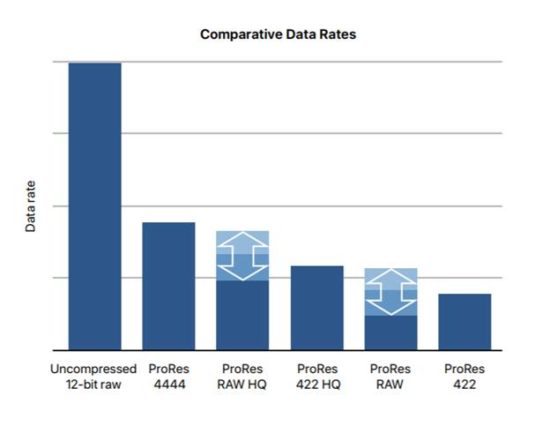Apple introduced an addition to its popular ProRes format at NAB 2018: ProRes Raw. ProRes has been a popular content creation format especially among Apple users and for FCP. It is supported by many cameras but most of those camera companies also have their own RAW formats, which give content creators much more latitude in working with the content direct from the camera. By introducing an acquisition format like ProRes Raw, Apple is seeking to do an end run directly to the camera makers sensors. Its version of RAW is more compact than standard versions of RAW, and it is Apple’s hope that ProRes Raw will become a standard for camera companies and software.
Apple’s ProRes Raw is a more compact version of ProRes. Apple is taking advantage of its knowledge of ProRes to be able to create ProRes Raw. As formats go up, video files are becoming more unwieldy. However, the minute one starts talking about compressed RAW, there is also a question of how RAW a format really is. Apple claims ProRes Raw is pretty raw with artifacts being indiscernible…mostly.

ProRes Raw got a really good start at NAB 2019. Assimilate’s CEO Jeff Edson announced support for ProRes Raw in his company’s Scratch post-production software, which handles conforming, color grading, special effects, compositing, finishing, and mastering. Edson said that ProRes is already a widely used format for content creation. We have seen numbers claiming 80% acceptance of ProRes in the camera market. ProRes Raw should therefore be a relatively easy transition based on acceptance in the ecosystem.
According to Edson, “there is potential for ProRes Raw to become a ubiquitous camera format, which means camera manufacturers would no longer need to develop the variety of SDKs, resulting in significant cost savings, lowering the barrier to entry, and streamlining the camera workflow.”
When Apple first published its white paper on ProRes Raw in 2018, only Atomos and DJI announced support for ProRes Raw support. At NAB 2019, momentum for ProRes Raw has grown with partners arriving from the transcoding, NLE, and color grading companies. In addition to Assimlate, Filmlight, Colorfront, Telestream, MTI film, and Grass Valley have announced support for ProRes Raw. Still no additional camera companies. Video news site Cinema5D interviewed Atomos CEO Jeromy Young who claimed the long wait is understandable. Last year was version 1.0 he cautioned and said it has taken all this time for Apple to develop an SDK. He’s confident support will come and was willing to say that by NAB 2020, over 20 cameras will offer support for ProRes Raw but he expressed support for the kind of gradual rollout we’re seeing. In the meantime, Atomos recorders offer an intermediate step between cameras and the software.
There is not a huge amount of urgency given that two of the largest video editing programs in the market, Apple’s Final Cut Pro and Motion support ProRes Raw, and now more professional tools were announced at NAB 2019. According to industry reports, Adobe said they support ProRes Raw in an errant presentation slide, which promptly disappeared. Based on that, many are betting that support for ProRes Raw is on the way for Adobe’s products. Last year, camera makers Aja and Blackmagic announced their own RAW formats that support ProRes. So, maybe it makes sense they’re hanging back on ProRes Raw.
Jeff Edson told us that the industry is hungry for simplification. Small companies are having a hard time negotiating the unleashed zoo of formats, codecs, and resolutions and large companies are going to IP because they need the flexibility.





